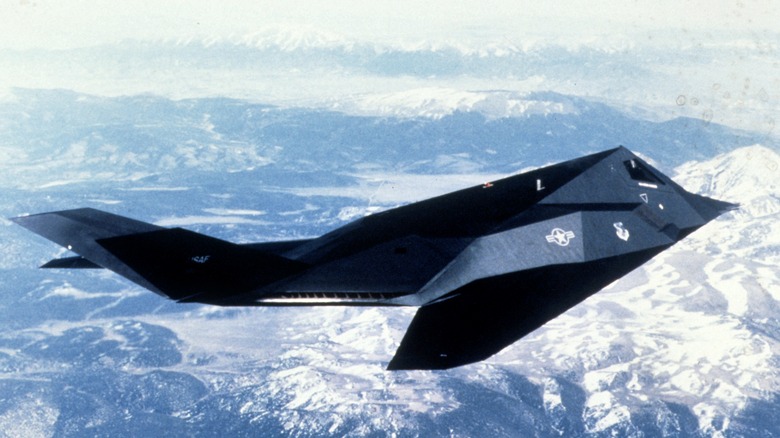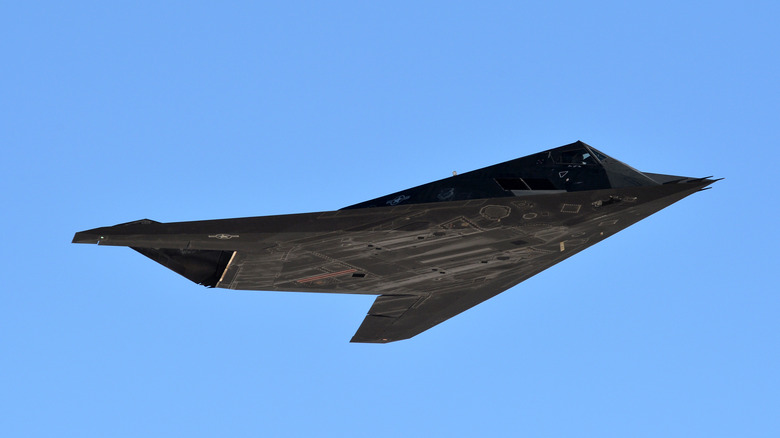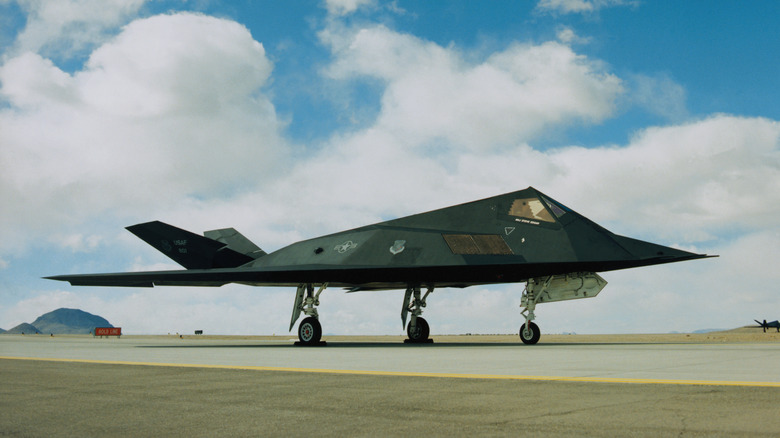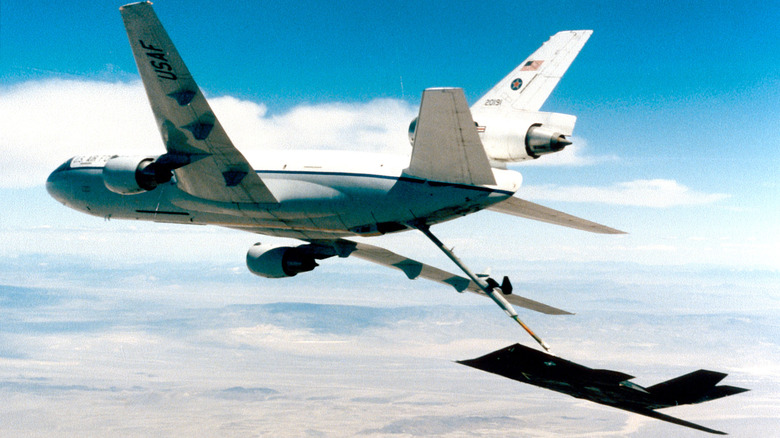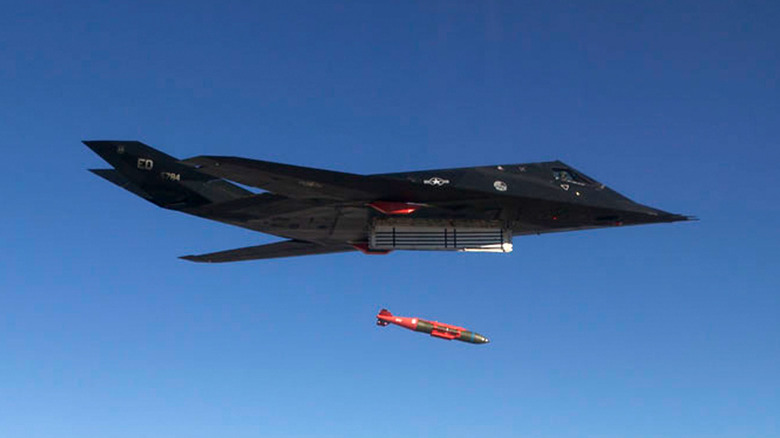F-117 Nighthawk: America's First 'Invisible' Stealth Jet
Stealth technological marvels like the F-22 Raptor and F-35 Lightning II didn't just happen overnight. Both aircraft are the result of decades of research and experiments to make aircraft undetectable. The grandfather of all stealth aviation is the F-117 Nighthawk, not only the United States' first stealth aircraft, but the first in the world. But what's behind the tech that comprises the F-117's angular airframe, and what's so special about so-called stealth technology anyway?
Prior to the F-117”s first flight in 1981, enemy (primarily Soviet) radar installations attached to surface-to-air missile systems were the bane of existence for any plane daring enough to enter airspace where it wasn't supposed to be. Aircraft design doctrine at the time dictated that the faster you make a jet, the easier it could avoid enemy firepower, hence the F-15 Eagle, which topped out at a wickedly fast speed of 1,875 miles per hour. But even the fastest jets can still be shot down.
That's where stealth technology comes in. In the 1970s, American engineers developed materials and construction techniques to use in aircraft that negated the need to worry about enemy radar because it bypassed it altogether, effectively making the radar and subsequent missiles "blind." The exact nature of said materials are classified, but essentially they allowed aircraft to absorb and reflect radar waves around it. It's important to note that stealth aircraft are not actually "invisible" to radar as each plane still takes up physical space, but stealth technology allows the aircraft to appear smaller on radar, essentially making it undetectable or harder to observe.
Practically a UFO
The Nighthawk itself started out as a project code named "Have Blue" by Lockheed Martin in 1975. After demonstrating it to the military brass at the Defense Advanced Research Projects Agency (DARPA), Lockheed won the contract to build the first-ever stealth jet. By 1977, there was a working prototype, and, by 1981, the U.S. Air Force was on board. In 1983, it was officially in service. However, the public didn't become aware of the plane's existence until 1988.
The F-117 Nighthawk, nearly 50 years after the prototype's first flight, still doesn't quite look like any other plane that came before it or after it. It's almost alien in appearance and may have been the culprit of some supposed UFO sightings. If you weren't in the know, seeing the F-117 fly past would probably be a terrifying experience and an Air Force jet probably wouldn't be your first thought in surmising what it was. It looks more like something Batman would fly than anything else.
Slow and stealthy
Underneath the almost impossibly angular exterior are two General Electric F404 engines (the same used in the F-18 Hornet) that generate a combined 21,200 lbs of thrust. And, despite its looks, the Nighthawk isn't particularly fast. According to the National Museum of the Air Force, the F-117's maximum cruising speed is 684 miles per hour, just slightly under supersonic speed. Frankly, it wasn't fast because it didn't need to be.
For armaments, the F-117 was also somewhat limited in that it could only carry 5,000 pounds of ordnance and did not have any guns onboard, making it strictly a bomber. It was given the "F" for "fighter" designation by Tactical Air Commander Gen. Robert J. Dixon who wanted to spice up the plane. After all, there are few more intriguing military items than fighter jets, especially ones that are "invisible." All Nighthawk pilots were given the nickname "Bandit."
Extensive combat history
The F-117 actually saw a substantial amount of combat during its service life. It was first used during the U.S. Invasion of Panama in 1989 and became world famous during Operation Desert Storm in 1990 where it flew 1,271 sorties over Baghdad, Iraq, against Saddam Hussein's forces. Reportedly, not a single F-117 was damaged during the fighting.
However, that perfect record would only last until 1999, during NATO's bombing of targets in the former Yugoslavia (now Serbia). On March 27th, 1999, Serbian anti-aircraft battery commander Zoltan Dani scored the first ever successful hit of a F-117 using modified equipment. Lt. Col. Dale Zelko was flying the Nighthawk that night and safely ejected before the plane crashed and was recovered by Serbian forces. The recovered aircraft is still on display and Dale Zelko and Zoltan Dani became friends after the mission. But that hit eventually sealed the fate of the F-117.
A nearly perfect record
By 1999, the F-117 was showing its age as an aircraft that would later become the F-22 Raptor had begun test flights as early as 1997. The Nighthawk would see service into the Invasion of Iraq in 2003, but was retired from active military service in 2008, three years after the full-production F-22 entered service. However, the Air Force still maintains and flies a number of Nighthawks for training and demonstration purposes. Only 59 F-117A Nighthawks, the sole variant, were ever produced.
From the mid-1970s, until 1999 when it was bested by a skillful anti-aircraft commander, the United States was flying the most advanced combat jet in the world. In 2023, as other countries like China and Russia have entered the stealth game, the F-117 is almost quaint from a technology perspective. However, no aircraft today quite comes close to the Nighthawk's mystique and impact in the world of combat aviation.
